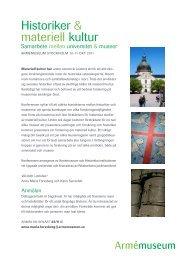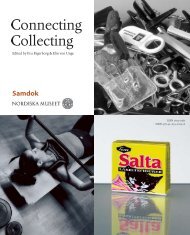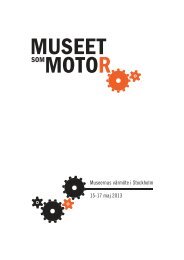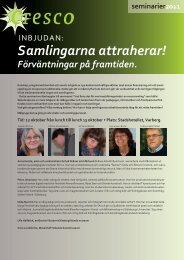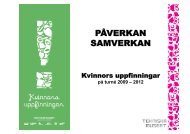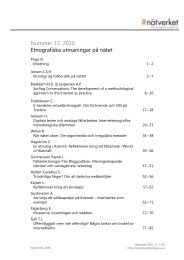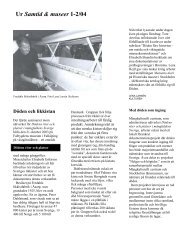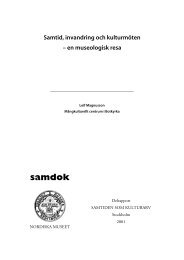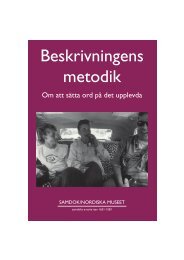The Pool for Local and Regional SpheresBetween preservation and chanWhat traces do societalchanges leave on the physicalenvironment? That isthe overall question askedby the Pool for Local andRegional Spheres. The poolhas become an importantforum where participants canpresent ideas for projects,ongoing work, and results forshared discussions.By Barbro Mellanderand Anna Ulfstrand»In the 1970s the museums beganto work with cultural heritagemanagement, that is to say, they tookpart in community planning by identifyingphysical environments that are worthcaring and preserving. That work wasoften done separately from the museumwork with ethnology and cultural history,which in turn meant that the physicalsites were reduced to mere physical sitesand their links to non-material culturaland historical values disappeared. Oneof the pool’s most important tasks hastherefore been to serve as a forum wherethese two perspectives can be reconnected,as well as a place where scholars andpractitioners can meet.Another aspect is that the museumshave a dual role when working bothto build up knowledge and to performcultural and historic valuations. Sincethis is interesting from a museologicalperspective, the pool has included in itspolicy statement the task of scrutinizingthe selection criteria that serve as a basisfor preservation. Questions that can thenbe asked are, for example, whose culturalheritage we preserve for the future andfor whom it is preserved.From this perspective StockholmCounty Museum has examined the municipalprogramme for cultural heritagemanagement that the museum drew up,to examine how local history is presentedin it and used in the selection of sitesthat are considered worthy of preservation.It turned out that the descriptionswere free of conflict and poor innon-material traces. The programme’sassessments of the different sites centredaround three main themes: the unique,the typical, and the aesthetically pleasing.Sites that were well-preserved anduntouched by change were given thehighest status in the programme, whichmeans that narratives about how peoplehave used the sites have in many casesbeen rendered invisible.The Big City Project – assemblingknowledge about post-war buildingThe pool began its work at roughly thesame time as the project The Architectureand Cultural Environment of theBig City was launched, partly funded bythe National Heritage Board. The aimof the project was to develop work withthe built environment, especially in thesuburbs of the big cities built after 1945.Several of the pool members from local,regional, and national museums and twouniversity departments worked on theproject, and the project’s questions aboutpreservation and the user’s perspectivewere the theme of one of our first poolmeetings in Gothenburg.At this time the Swedish Museum ofArchitecture started an interview studywith many of the architects and plannerswhose work was mostly done inthe 1950s–1970s, and who had exerteda great influence on how Sweden wasplanned and built. They also interviewedsome of the people who had writtenabout the housing issue during the period.Bromölla and Södertälje – thewelfare state materializedModern industrial society has also beena theme of the pool’s work. Two majorprojects have dealt with communitiesThe welfare state is materialized. In the study of Bromöllathe Regional Museum and the director of museumsand sites in Skåne looked for the stories that buildingscan tell about a community in development and change.Photo: Ulla-Carin Ekblom©Regionmuseet Kristianstad.built up around, and depending on, largedominant industrial companies. TheRegional Museum and the director ofmuseums and sites in Skåne carried outa methodological study in the industrialcommunity of Bromölla to find out whatthe material expressions of a modernindustrial society can say about post-warpolitical, economic, and social changes.They also wanted to test new methods inthe study of the built environment. Thework did not proceed from the traditionalquestions asked in cultural heritagemanagement, which are often concernedwith the authenticity, representativeness,12 • Samtid & museer no 2/07
The Pool for Local and Regional Spheresge the built environment as a mirror of the timesPetra is busy tearing down walls to create anopen plan in the family’s newly purchasedhouse. Change was the key word whenStockholm County Museum documentedBerghem, which has developed in thirty-fiveyears from being a homogeneous to a heterogeneoushousing estate. Photo: ElisabethBoogh, Stockholm County Museum.and uniqueness of the buildings. Insteadthey looked for the stories the buildingstell about a society in development andchange. The project was carried out indialogue with inhabitants of Bromölla,which gave the museum insight intoalternative ways of understanding andremembering buildings.Stockholm County Museum, togetherwith Södertälje municipality and theStockholm County Administration, havebeen working for a couple of years withthe influence of the companies Scaniaand Astra on housing in Södertälje. Inthe post-war years the companies expandedvigorously, and being able tooffer housing was a condition for thepotential to recruit both blue-collar andwhite-collar staff. The questions askedby the study concern the companies, themunicipality, and their relations, as wellas how inhabitants of Södertälje thenand now have perceived the city andits changes. Both the Bromölla and theSödertälje studies also give a local perspectiveon the grand narrative of Swedishmodernity.From group houses to detachedhousesAnother example of a study inspired bythe pool’s policy statement is StockholmCounty Museum’s study of the Berghemhousing estate in Järfälla municipality. Abuildings antiquarian and an ethnologistcollaborated in a study of the area, whichwhen it was built at the end of the 1960sconsisted of 142 identical houses of thetype known as “WP-villa”. Today mostof the houses have been transformed indifferent ways. Many have been paintedin other colours, some have been givennew roofs or entrances. In this study thequestions concerned why the houseshad changed and what this can say abouthow society has changed in the fortyyears that have passed since the firstfamilies moved in.A street in StockholmThe pool’s policy statement also declaresthat an interesting topic is how place andidentity interact. The starting point isthat the concept of identity has changedin late modern society, which meansthat given positions and identities are increasinglyquestioned. For our pool it isof particular interest to see how identityseeking and identity formulation are relatedto the spaces, or places, where thisis enacted. How, for example, do peopleclaim the public space? How are placesaffected by the individuals and groupswho use them?Some of these questions recur in theproject Götgatan, which Stockholm CityMuseum conducted during one week inJanuary 2003. The street is mentionedfor the first time in 1494, and it has followedroughly the same course sincethen. The point of departure was thatchanges in Götgatan happen simultaneouslyin several chronological layersand at different speeds. It is both representativeand specific, both generaland unique to Stockholm. It is a partof a city and it is a local whole with abeginning and an end. The documentingteam wanted to find methods thatcould shed light on changes in the streetin the course of a day and night, as wellas more lasting phenomena. They useddifferent interview techniques: one fastwith short questions for passers-by and adeeper one with some people for whomthe street was their workplace. Theyphotographed, filmed, recorded streetnoises, and made quick notes about whathappened in the street. Posters and anumber of artefacts were collected. Thegroup, which worked virtually round theclock during the week, hopes to be ableto return at regular intervals in orderto collect material reflecting the streetand changes in street life over a longerperiod.The future of the poolTo sum up, the pool has been both usefuland pleasurable for those taking partin it. Our questions have changed overthe years, and when we revised our policystatement a couple of years ago, wenoted that much of what we thought wewere alone in discussing during the firstyears were questions that are now consideredimportant in the sector. We hopein future to be able to assemble aroundjoint projects where we can sharpen ourquestions or perhaps ask completely newquestions as society changes. pBarbro Mellander is regional director ofmuseums and sites and head of RegionmuseetKristianstad and chair of the Pool for Local andRegional Spheres,barbro.mellander@regionmuseet.m.seAnna Ulfstrand is ethnologist and photographerat Stockholm County Museum and secretary ofthe pool for Local and Regional Spheres,anna.ulfstrand@lansmuseum.a.seSamtid & museer no 2/07 • 13



